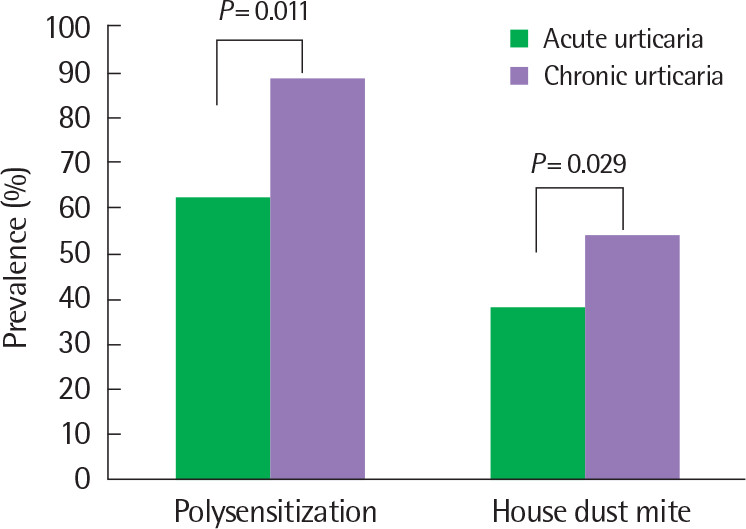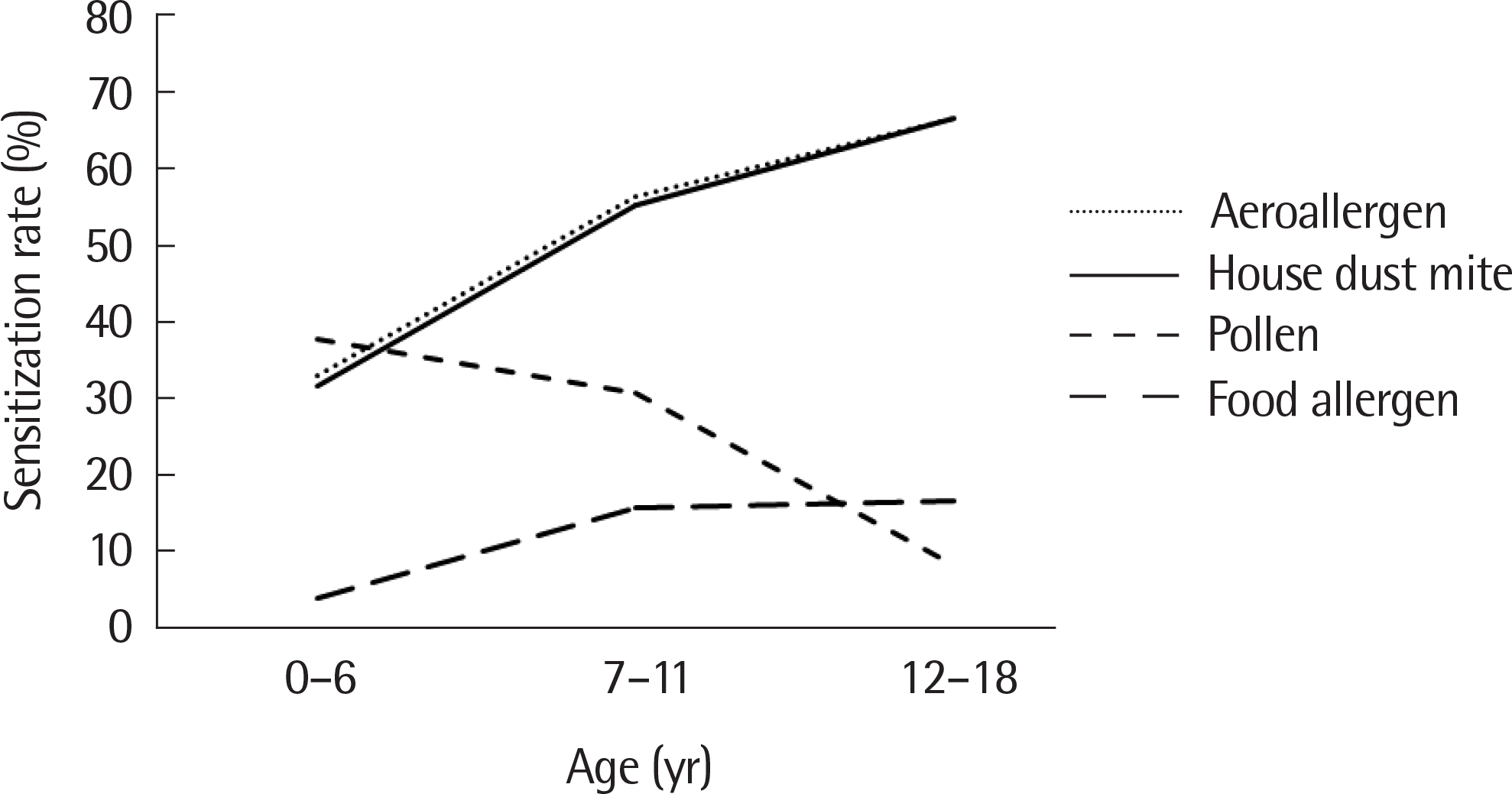Abstract
Purpose
Urticaria is a common disorder, with a lifetime incidence of approximately 15%–20% of the general population. It is difficult to differentiate urticaria in children because of the similarity in symptoms between acute and chronic urticaria. There is also a lack of studies between vitamin D known as an important role in the immune system and urticaria in children. The present study aimed to assess the characteristics and allergen sensitization of young children diagnosed with urticaria and to evaluate the relationship between their vitamin D status and urticaria.
Methods
We retrospectively reviewed medical records of 218 children diagnosed as having urticaria at CHA and Myongji Hospitals between April 2013 and December 2014. The results of questionnaires and laboratory tests, including specific IgE and serum 25-hy-droxy vitamin D concentrations were obtained.
Results
Of 218 patients, 118 (54%) were positive for at least 1 allergen and there was no significant difference in the prevalence of sensitization between the acute and chronic urticaria groups. However, the prevalence of polysensitization and sensitization of house dust mites was significantly higher in the chronic urticaria group than in the acute urticaria group (P=0.011 and P=0.029, respectively). Among the urticaria symptoms, an itching sensation was more associated with insufficient vitamin D status in children with urticaria (P=0.034).
Conclusion
Our results demonstrated that children with chronic urticaria have a higher prevalence of sensitization to house dust mites and polysensitization. Further studies will need to determine whether the supply of vitamin D can improve itching sensation in urticaria children with an insufficient vitamin D status.
Go to : 
REFERENCES
1. Nettis E, Pannofino A, D'Aprile C, Ferrannini A, Tursi A. Clinical and ae-tiological aspects in urticaria and angio-oedema. Br J Dermatol. 2003; 148:501–6.

2. Sackesen C, Sekerel BE, Orhan F, Kocabas CN, Tuncer A, Adalioglu G. The etiology of different forms of urticaria in childhood. Pediatr Dermatol. 2004; 21:102–8.

3. Zuberbier T, Bindslev-Jensen C, Canonica W, Grattan CE, Greaves MW, Henz BM, et al. EAACI/GA2LEN/EDF guideline: definition, classification and diagnosis of urticaria. Allergy. 2006; 61:316–20.

5. Kaplan AP. Clinical practice. Chronic urticaria and angioedema. N Engl J Med. 2002; 346:175–9.
6. Hannon GR, Wetter DA, Gibson LE. Urticarial dermatitis: clinical features, diagnostic evaluation, and etiologic associations in a series of 146 patients at Mayo Clinic (2006-2012). J Am Acad Dermatol. 2014; 70:263–8.
7. Volonakis M, Katsarou-Katsari A, Stratigos J. Etiologic factors in childhood chronic urticaria. Ann Allergy. 1992; 69:61–5.
8. Hide M, Francis DM, Grattan CE, Hakimi J, Kochan JP, Greaves MW. Autoantibodies against the high-affinity IgE receptor as a cause of histamine release in chronic urticaria. N Engl J Med. 1993; 328:1599–604.

9. Agmon-Levin N, Theodor E, Segal RM, Shoenfeld Y. Vitamin D in systemic and organ-specific autoimmune diseases. Clin Rev Allergy Immunol. 2013; 45:256–66.

11. Hossein-nezhad A, Holick MF. Vitamin D for health: a global perspective. Mayo Clin Proc. 2013; 88:720–55.

12. Pludowski P, Holick MF, Pilz S, Wagner CL, Hollis BW, Grant WB, et al. Vitamin D effects on musculoskeletal health, immunity, autoimmunity, cardiovascular disease, cancer, fertility, pregnancy, dementia and mortality-a review of recent evidence. Autoimmun Rev. 2013; 12:976–89.

14. Kulthanan K, Jiamton S, Thumpimukvatana N, Pinkaew S. Chronic idiopathic urticaria: prevalence and clinical course. J Dermatol. 2007; 34:294–301.

15. Mathias SD, Dreskin SC, Kaplan A, Saini SS, Spector S, Rosén KE. Development of a daily diary for patients with chronic idiopathic urticaria. Ann Allergy Asthma Immunol. 2010; 105:142–8.

16. Kulthanan K, Chiawsirikajorn Y, Jiamton S. Acute urticaria: etiologies, clinical course and quality of life. Asian Pac J Allergy Immunol. 2008; 26:1–9.
17. Kang HS, Shin MY. Clinical aspects of chronic urticaria in children. Korean J Pediatr. 2009; 52:205–12.

18. Choi SY, Park HY, Ahn YM. Chronic urticaria in childhood: etiology and outcome. Pediatr Allergy Respir Dis. 2007; 17:38–47.
19. Caliskaner Z, Ozturk S, Turan M, Karaayvaz M. Skin test positivity to aeroallergens in the patients with chronic urticaria without allergic respiratory disease. J Investig Allergol Clin Immunol. 2004; 14:50–4.
20. Chang KL, Yang YH, Yu HH, Lee JH, Wang LC, Chiang BL. Analysis of serum total IgE, specific IgE and eosinophils in children with acute and chronic urticaria. J Microbiol Immunol Infect. 2013; 46:53–8.

21. Kim EJ, Kwon JW, Lim YM, Yoon D, Seo JH, Chang WS, et al. Assessment of Total/Specific IgE Levels Against 7 Inhalant Allergens in Children Aged 3 to 6 Years in Seoul, Korea. Allergy Asthma Immunol Res. 2013; 5:162–9.

22. Yoon JW, Lee SM, Kim JH, Kim NY, Baek JH, Baek HS, et al. Sensitization patterns to common allergens in Korean children younger than 6 years of age presenting with typical symptoms or signs of allergic diseases: a single center study. Allergy Asthma Respir Dis. 2014; 2:272–6.

23. de Jong AB, Dikkeschei LD, Brand PL. Sensitization patterns to food and inhalant allergens in childhood: a comparison of non-sensitized, monosensitized, and polysensitized children. Pediatr Allergy Immunol. 2011; 22:166–71.
24. Thorp WA, Goldner W, Meza J, Poole JA. Reduced vitamin D levels in adult subjects with chronic urticaria. J Allergy Clin Immunol. 2010; 126:413.

Go to : 
 | Fig. 1.Comparison of polysensitization and house dust mite antigen sensitization in patients with acute and chronic urticaria. The prevalence of polysensitization and sensitization of house dust mites is significantly higher in the chronic urticaria group than in the acute urticaria group (P=0.011 and P=0.029). |
 | Fig. 2.Distribution of aeroallergen and food allergen sensitization in urticaria children by age. Aeroallergen sensitization rates, including house dust mite and pollen show a tendency to increase with age. However, the rate of food allergen sensitization tends to decrease with age. |
Table 1.
Demographic characteristics of the study populations
Table 2.
Comparison of serologic tests and allergen sensitization betwee acute and chronic urticarial
Table 3.
Prevalence of positive serum specific IgE tests in acute and chronic urticarial
Table 4.
Comparisons of clinical characteristics and allergen sensitization b serum 25-hydroxy vitamin D (25(OH)D) level in urticaria patients




 PDF
PDF ePub
ePub Citation
Citation Print
Print


 XML Download
XML Download